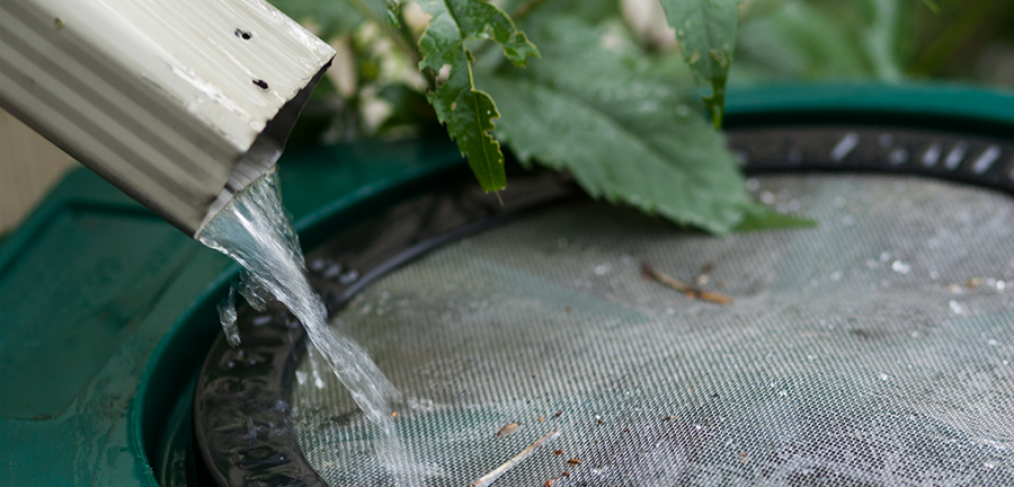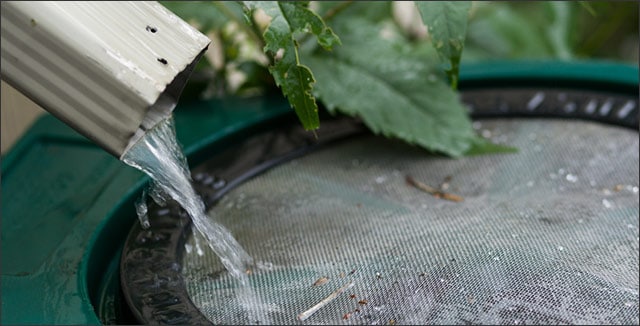
How to Harvest Rainwater for Reuse Instead of Sending it to the Sewer

It’s no secret that water is a precious resource which some in this world don’t have access to. It’s also no secret that the toilets and showers we take for granted in most of the United States use a lot of water.
In addition, it’s shocking how much water gets used every day for the most basic tasks. An average household with newer plumbing fixtures: 1.6-gallon-per-flush toilets and 2.5-gallon-per-minute shower heads uses roughly 55 gallons per person per day.
If you live in a rainy part of the world, you might actually be wondering how to drain water from your backyard every spring, instead of how to grow drought-resistant plants. However, the most important thing is to be mindful of the water you use and of where your rainwater goes.
Did you know that some sewer systems are combined with the storm drainage system? In such cases, when a big storm or a lot of rain come there is potential for sewage to get into the nearby waterways – rivers, lakes and streams.
Of course, you can contact your local government to find out if this is true of your community. It will surely make you think twice about dumping all your downspouts into the storm drain.
What you can do instead of sending rainwater into the sewer
When sidewalks and roads get built, valuable green space which can absorb excess water is covered. The larger an area of land covered in concrete, the less land space there is to absorb rain and the more of that water goes into the storm drains.
Even if your storm drain isn’t combined with the sewage line, rainwater washing over lawns and pavement picks up all kinds of nasty things: fertilizers, pesticides, oil and grease from cars, and bacteria from pet waste – and dumps it into the river. It’s not much better than a sewage backup.
You know by now, dirt is made to filter water and waste. It can turn toxic, disease-ridden waste into usable dirt over time, and it can clean dirty water while letting it slowly filter down into underground aquifers. Not so with concrete and asphalt.
The more water we send to the wastewater treatment plant, the more money we have to spend on a complicated process the ground does for us naturally.
Did you know that a 1,000 square foot roof can harvest 600 gallons of water for every inch of rain that falls? If all you can do is keep that much water from hitting the sewers, that’s a huge difference for the environment. In dryer climates, it just might be the way to be fully self-sufficient.
How to Harvest Rainwater
A cheap, easy, and viable option for collecting rainwater that anyone can do right now is to install rainwater collection barrels.
You can use rainwater collected from an asphalt roof for gardening and washing your cars – any non-potable use. However, you can’t drink it or shower in it. Asphalt roofs have toxic chemicals which can leech into the water as it runs off.
Collecting water for gardening is not hard. You need a big storage tank – a plastic 50 gallon barrel works just fine and is pretty cheap. You also need a screen to keep out debris and a way to let the water out, such as a spigot near the bottom of the barrel.
With a simple spigot and a hose, you can allow gravity to drain the water into the garden. Another option is a small 1 horsepower pump which would allow you to spray your garden right from the barrel.
Harvest Rainwater for Use in Your House
There is a way to harvest rainwater for all your household needs. You do have to have non-toxic roofing material: unpainted galvanized metal, clay, slate or tile. In addition, your gutters have to be non-toxic: seamless aluminum or vinyl, without lead-based soldering and with leaf screens. Even if you have those in place, however, if you live in an industrial area where the air is full of pollution, the rainwater may never be safe to drink.
The next part of collecting potable rainwater is a storage tank and pump system. There’s a wonderful overview of this process on This Old House.
Keep in mind that your roof – the collection system upon which you will be relying – has to be maintained more than usual. You need to keep it free of debris and keep the screens clean as well. According to the article above:
“The cost of a 10,000-gallon tank, PVC lines to and from the house, all filters, UV light, pressure tank, and pump runs about $7,500 to $9,000. To entice more participants—and thereby relieve overburdened water service—Austin, Portland, Oregon, and other cities are offering incentives like tax-free equipment or property-tax rebates to install collection systems.”
Benefits to Harvesting and Storing Rainwater
There are definite benefits to harvesting and storing rainwater for all your water needs.
- You’ll Save Money in the Long Run
The up-front cost to rainwater harvesting isn’t cheap. You might spend around $25,000 to set yourself up, but you will end up paying yourself back in time. Instead of city water bills or troubles with your well, you will only end up paying to run a small electric pump for the month. All the rest of the “harvesting” is done when you’re sitting inside. - The water you get after you filter the rainwater you harvest is chemical and mineral free.
That means all your clothes and skin rinse clean without residue. And you don’t have to treat it with a water softener. It’s free of the chlorine found in all city water as well. You won’t find any mineral buildup on your bathroom fixtures either. - The self-sufficiency you gain using this system is immeasurable.
Think about not relying on the city or the electric company (to power the pump for your well) for your water! You’re not overwhelming the sewer system with your runoff, and you’re doing your part to keep your local rivers clean.
State Laws and Restrictions on Harvesting Rainwater
Some states have restrictions on harvesting rainwater including:
- Arizona
- Arkansas
- California
- Colorado
- Hawaii
- Illinois
- Nevada
- North Carolina
- Ohio
- Oklahoma
- Oregon
- Rhode Island
- Texas
- Utah
- Virginia
- Washington
- U.S. Virgin Islands
If you state is listed above, be sure to check the National Conference of State Legislatures State Rainwater Harvesting Laws and Programs before you start harvesting rainwater.
Take Away
As you consider doing your part to live sustainably, think about how you can harvest rainwater for reuse instead of sending it down to the gutter. Your town and garden (maybe even your shower) will thank you!
For more on saving money watering your trees and plants, please see Deep Root Systems for Trees and Plants



